|
Introduction
In this white paper we examine e-commerce grocery order fulfillment to analyze the paid manpower requirements to fulfill online orders using five (5) different approaches. We then compare these results against a Baseline Scenario whereby the shopper goes to the store to buy their merchandise. The objective is to identify the incremental paid labor hours and cost required to perform order fulfillment of online grocery orders. The goal is to educate the reader on several key learning lessons:
- The incremental time and money required for grocery companies to fulfill online orders is significant. Shoppers should expect to pay more for their grocery basket as a result because the convenience of online shopping has a steep price tag.
- Behind the scenes, there are different methodologies being used to fulfill online grocery orders including: in-store valet shopping, conventional dark stores, automated micro-fulfillment centers and automated customer fulfillment centers. Each approach requires a different amount of paid labor to fulfill the customer's online order. This white paper examines each of these cost components to illustrate the order of magnitude of paid labor requirements for each type of fulfillment strategy.
- There is a significant increase in paid labor requirements and cost to perform the last mile home delivery of online groceries as compared to curbside pickup. This white paper helps consumers to understand how this cost impacts their overall food bill.
Approach and Scenario Definition
When the consumer walks into a North American supermarket, depending on the size of the retail store footprint, there may be 20 – 50,000 different unique items to select from. With such a high variety of food products, how is it possible develop a simple and easy to understand story that enables consumers to understand the high cost of online order fulfillment? The answer is to simplify the problem by studying the supply chain cost components associated with one single item through multiple scenarios
As explained in the body of this report, we simplify the analysis by studying one item and following this item through five different supply chain scenarios. In this analysis, we pose the simple question: How many minutes of paid labor resources are involved in moving one entire pallet of Heinz Ketchup through the retail supply chain to the consumer's basket? Why use Heinz Ketchup? No reason at all. Any item could be used to arrive at the conclusions being made in this report.
As an item passes from supplier through the retail supply chain, it is typically handled in multiple formats (e.g. pallet, case, retail unit), therefore, the handling time and costs of each activity must pertain to the unit of measure being handled. This analysis examines how one entire pallet of Heinz Ketchup moves through the retail supply chain for five different scenarios so that we can identify the paid manpower required to supply one single retail unit to the consumer.
The scenarios examined are as follows:
- The Baseline Scenario: The consumer travels to the store and shops for their order in the store. The consumer picks the order and transports the merchandise to their home. This traditional approach represents how the vast majority of grocery merchandise is consumed. It is the baseline against which all other scenarios are compared.
- Scenario 2: Sale of merchandise through the online channel whereby the order is picked by an in-store valet shopper and then delivered by the valet to the customer's home. For example, this approach is used by Instacart to fulfill online orders on behalf of many grocery retailers.
- Scenario 3: Sale of merchandise through the online channel whereby the order is picked in its entirety from an automated Micro-Fulfillment Center (MFC) which is located in the back room of a retail supermarket. The order is then delivered to the customer's home by a Delivery Service Provider (DSP).
- Scenario 4: Sale of merchandise through the online channel whereby the order is manually picked from a “Dark Store” (i.e. a retail store that is turned off to the public). Orders are then delivered to the customer's home by a Delivery Service Provider (DSP).
- Scenario 5: Sale of merchandise through a manually operated food fulfillment center (e.g. Amazon Pantry or Fresh but without Amazon Robotics automation).In this scenario, the order is picked using a manual pick cart and then the order is delivered to the customer's home by a Delivery Service Provider (DSP).
- Scenario 6: Sale of merchandise through an automated customer fulfillment center (e.g. Amazon Fresh or Pantry) whereby the order is picked using a goods to person automation system (e.g. Amazon Robotics, Autostore, etc.) and then the order is delivered to the customer's home by a Delivery Service Provider (DSP).
For each scenario we document the multiple paid labor processes involved within the supply chain including: receiving; restocking; picking; sorting/staging; shipping; and delivering the order to the consumer's home. This analysis calculates by process the paid labor requirements to move one pallet of Heinz ketchup to market so that we can understand the order of magnitude of labor requirements required for each scenario.
Does this approach have flaws that can be critiqued? Absolutely yes. One obvious critique is that the consumer needs to spend time to travel to the store and to shop their order which we exclude from the Baseline Scenario. We exclude this activity because it does not involve paid labor since the consumer serves the role of order picker and delivery driver in this scenario. This exclusion is by design because consumers do not get paid to shop for their own groceries.
The findings and conclusions of this report are directionally correct in that they look through a specific lens which is attempting to answer the question: How much additional labor cost does the retailer incur to fulfill online orders as compared to selling the same merchandise from the retail store? Why is this important? This is not just a question of economics, it is also a question of how many people are needed to move food to market in an era when viral infections can significantly alter the manpower available to perform the work.
Assumptions and Approach
For the purpose this analysis, we have selected a sample grocery item that is familiar to most people: Heinz Ketchup 38 oz. Squeeze Bottle: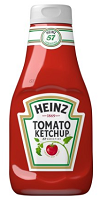
- Vendor Carton: 12 retail units per master case
- Vendor Pallet: 60 cases per Pallet
- Total Retail Units per Vendor Pallet = 60 x 12 = 720 Retail Units per Pallet
We assume the following hourly labor costs which include fringe benefits:
- Warehouse labor costs $35/hour
- Retail store labor costs $20/hour
- Delivery driver labor costs $25/hour
For the purpose of this analysis, the approach is to start the clock at the point in time when the vendor pallet arrives at the retail distribution center. The inbound transportation function to the retail distribution center and the store is purposely excluded from the analysis because these functions are neutral to the discussion at hand. Regardless of the scenario being evaluated, the transportation work required to move merchandise to the point of order fulfillment is a function of geography and is neutral across all scenarios. The relevant question we are trying to answer is : How many paid minutes of manpower are required to sell one pallet of this merchandise to market for five different online fulfillment options?
Scenario 1: Traditional Approach
Description: The consumer shops their order at the store and transports the merchandise to their home. This traditional approach represents how the vast majority of grocery merchandise is sold to market.
In the table below we calculate the paid manpower required at the distribution center to: receive, putaway and replenish inbound vendor pallets; to pick cases for outbound store orders; and to load mixed-SKU pallets onto outbound trucks which are then shipped to the store.
When the truck arrives at the store, pallets are unloaded at the backroom and cases are sorted and restocked to store shelves. The consumer shops the order and places the merchandise into their basket. The cashier scans the items at the register. If the self-checkout option is used by the consumer then the cashier time goes away and the minutes required to sell all 720 units on the pallet are reduced accordingly. We exclude the consumer's time to shop the order and transport the order home because we are only examining the paid manpower required for this exercise.
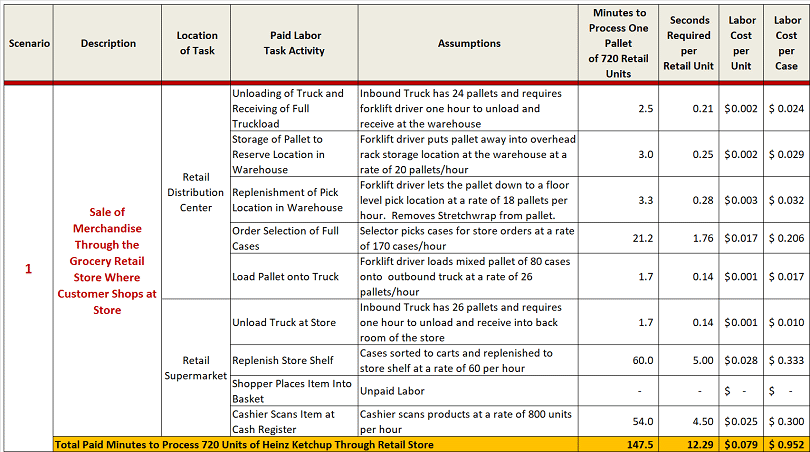
From the table above we conclude that 12 seconds of labor is required for the baseline scenario at a cost of $0.08 per retail unit.
Scenario 2: E-Commerce with In-Store Valet Shopper Approach
Description: The consumer stays home and orders online. A paid valet goes to the store and shops the order in the store. The valet then transports the merchandise to the consumer's home. The valet does this work for 3 orders per trip. This approach is similar to how Instacart functions.
In the table below we calculate the paid manpower required at the distribution center to: receive, putaway and replenish inbound vendor pallets; to pick cases for outbound store orders; and to load mixed-SKU pallets onto outbound trucks which are then shipped to the store. When the truck arrives at the store, pallets are unloaded and cases are sorted and restocked to store shelves.
The paid valet picks the customer order into a shopping basket and scans the items at a self-checkout register. Lastly the valet transports the order to the consumer's home.
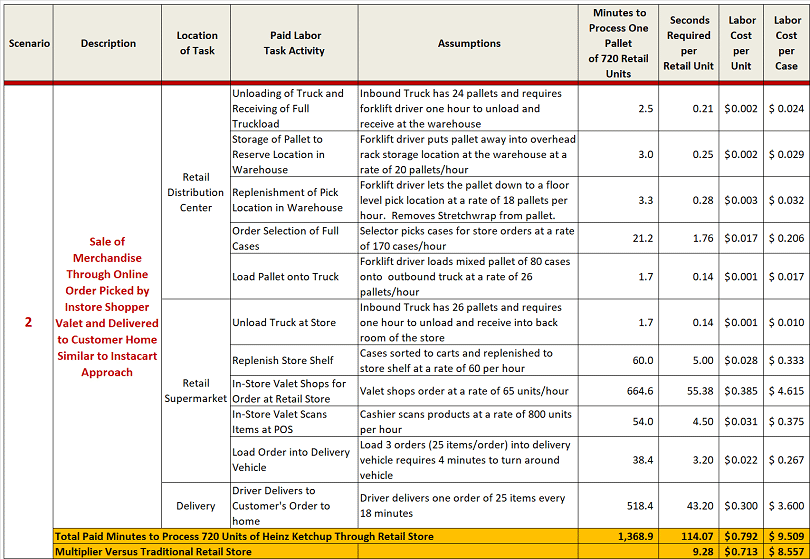
From the table above we conclude that 114 seconds of labor is required for Scenario 2 at a cost of $0.79 per retail unit. We also conclude that the paid manpower requirement is nine (9) times higher than the Baseline Scenario and the paid labor cost is higher by $0.71 per unit.
Scenario 3: E-Commerce with Automated Micro-Fulfillment Center Approach
Description: The consumer stays home and orders online. The retail store has a micro-fulfillment center (MFC) attached located in the backroom of the store. The MFC automation system increases productivity by eliminating travel time needed to pick the order. Goods are transferred to the order picker via robotic shuttle machines and conveyors. Order pickers work faster because they remain stationary throughout the day instead of traveling around a store.
In real life, approximately 50% of the items sold in a retail store would typically be processed through an MFC automation system with the balance of items are processed manually. In this example, we show what happens when the entire pallet of ketchup is picked through the automation system which is the most optimistic of “best case” version of this scenario.
In the table below we calculate the paid manpower required at the distribution center to: receive, putaway and replenish inbound vendor pallets; to pick cases for outbound store orders; and to load mixed-SKU pallets onto outbound trucks which are then shipped to the store. When the truck arrives at the micro-fulfillment center, pallets are unloaded and cases are opened and decanted into totes. The totes of product are then automatically stored into the MFC.
For picking of online orders, totes are automatically retrieved by the robots and transferred to static workstations where order selectors pick items and place them into bags in totes. Completed totes with merchandise are then moved to a staging area where products picked from the manual areas are consolidated with the portion of the order picked from the automation system. Orders are then loaded into delivery vehicles and drivers perform the last mile delivery function.
In this scenario, there are several peripheral functions that need to be performed when using MFC automation such as empty tote circulation, defragmenting the storage totes within the automation system, etc. Time has been added in the table to perform these functions because they are necessary tasks to keep the automation system up and running smoothly.
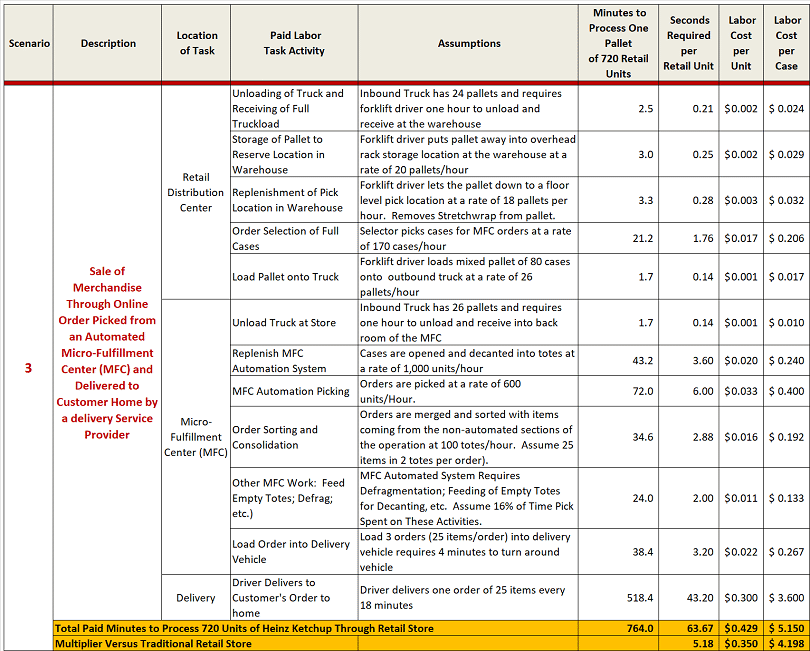
From the table above we conclude that 64 seconds of labor is required for Scenario 3 at a cost of $0.43 per retail unit. We also conclude that the paid manpower requirement is five (5) times higher than the Baseline Scenario and the paid labor cost is higher by $0.35 per unit.
Scenario 4: E-Commerce with Dark Store Manual Approach
Description of Approach: The consumer stays home and orders online. The order is sent to a “Dark Store” which is similar to a retail store except it is closed to the public. Orders are manually picked at the dark store by paid associates and the orders are delivered to the consumer's house by paid drivers.
In the table below we describe the manpower required to receive, putaway and replenish the pallet at the distribution center. We calculate the warehouse time spent to pick cases to replenish the dark store and then the time to load mixed-SKU pallets onto outbound trucks at the warehouse. When the truck arrives at the dark store, pallets are unloaded, and cases are restocked to the dark store shelves.
For picking of online orders, operators manually batch pick 5 orders per trip to a pick cart as they walk through the dark store. Completed orders are then loaded into delivery vehicles and drivers perform the last mile delivery function.
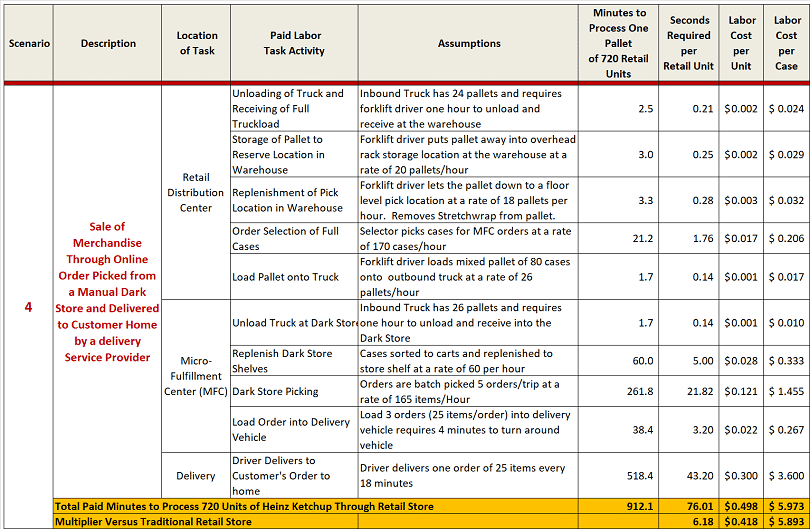
From the table above we conclude that 76 seconds of labor is required for Scenario 4 at a cost of $0.50 per retail unit. We also conclude that the paid manpower requirement is six (6) times higher than the Baseline Scenario and the paid labor cost is higher by $0.42 per unit.
Scenario 5: E-Commerce Through a Manual Customer Fulfillment Center
Description: The consumer stays home and orders online. The order is sent to a dedicated Customer Fulfillment Center (CFC) that is manually operated. The CFC is replenished by vendors such that the notion of the retail distribution center goes away in this scenario. Customer orders are manually picked at the CFC and the orders are then delivered to the consumer's house by paid Delivery Service Partners (DSPs) . This scenario may be similar to how Amazon operates its manual Fresh/Pantry and Prime Now facilities.
In the table below we describe the manpower required to receive and restock to the Fresh/Pantry fulfillment center shelves. For picking of online orders, we assume that operators manually batch pick 5 orders per trip to a pick cart as they walk through the fulfillment center. Completed orders are then loaded into delivery vehicles and DSP drivers perform the last mile delivery function.
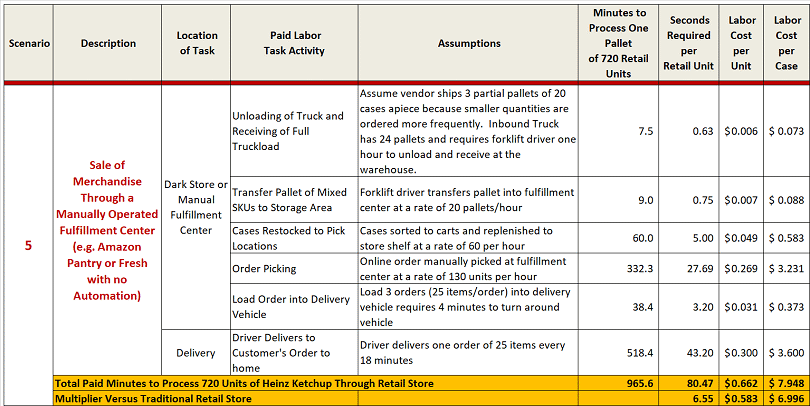
From the table above we conclude that 80 seconds of labor is required for Scenario 5 at a cost of $0.66 per retail unit. We also conclude that the paid manpower requirement is six (6) times higher than the Baseline Scenario and the paid labor cost is higher by $0.58 per unit.
Note that the retail distribution center labor cost is not included in this scenario because the distribution center work is being performed by the vendor instead of the retailer. It is a fallacy to assume that this work is done for free so in reality this scenario is more expensive than is depicted in the above table. If we look to Scenario 4 as a guideline for retail distribution center (RDC) labor then technically we should add the time and cost incurred at the RDC to this table. If we do this then the time requirement is closer to 83 seconds of labor at a cost of $0.69 per unit.
Scenario 6: E-Commerce Through an Automated Customer Fulfillment Center
Description: The consumer stays home and orders online. The order is sent to an automated customer fulfillment center (CFC) which is supplied directly by vendors such that the notion of the retail distribution center goes away in this scenario. Orders are picked using the Amazon Robotics automation system or Autostore automation system at the CFC and orders are then delivered to the consumer's house by paid DSP drivers.
In the table below we describe the manpower required to receive and restock merchandise to the Customer Fulfillment Center shelves. For the picking of online orders, operators pick from goods to person workstations such that travel time is eliminated. Instead the goods to person automation robots transfer the merchandise directly to the pick stations. Completed orders are loaded into delivery vehicles and drivers perform the last mile delivery function.
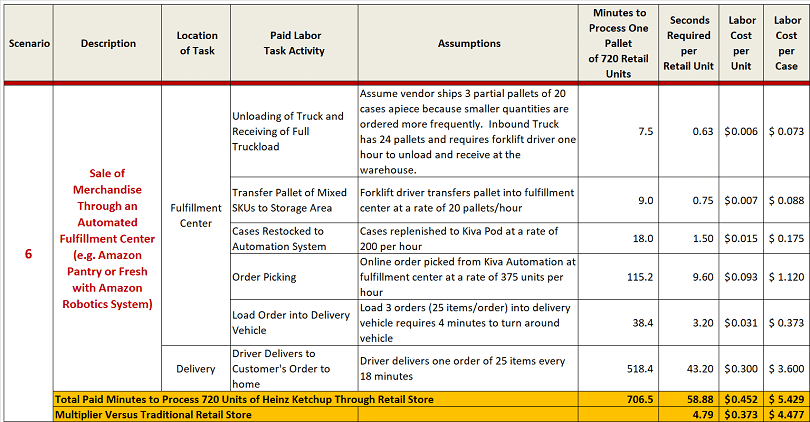
From the table above we conclude that 59 seconds of labor is required for Scenario 6 at a cost of $0.45 per retail unit. We also conclude that the paid manpower requirement is five (5) times higher than the Baseline Scenario and the paid labor cost is higher by $0.37 per unit.
Note that the retail distribution center labor cost is not included in this scenario because the distribution center work is being performed by the vendor instead of the retailer. It is a fallacy to assume that this work is done for free so in reality this scenario is more expensive than is depicted in the above table. If we look to Scenario 4 as a guideline for retail distribution center (RDC) labor then technically we should add the time and cost incurred at the RDC to this table. If we do this then the time requirement is closer to 62 seconds of labor at a cost of $0.48 per unit.
Findings and Conclusions
The table below summarizes the findings of this analysis. The conclusions reached indicate that regardless of how online orders are fulfilled, the cost per unit is higher than the Baseline Scenario because more paid labor is involved in picking and delivering the merchandise to the consumer's home.
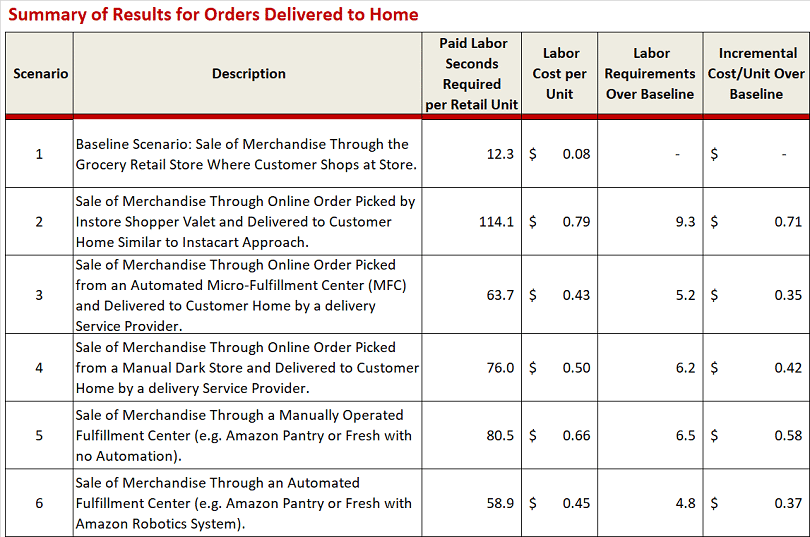
What do these results imply for the consumer? Over the course of conducting multiple consulting studies for retail grocery companies, we have determined that cost of the consumer's food basket should be between 20 – 25% more expensive to pay for the convenience of online shopping and home delivery services. If the retailer charges less then the retailer is absorbing some of this incremental cost in order to defend market share. The consumer should note that prices online may not necessarily be equal to prices in the store and that this policy varies by retailer.
The next question is what does the above table look like if the consumer shops online and drives to the supermarket for curbside pickup? The reason this question is important is because the last mile delivery function represents a large portion of the overall cost structure for online grocery fulfillment. The table below shows the same figures assuming the customer picks up their order at store curbside.
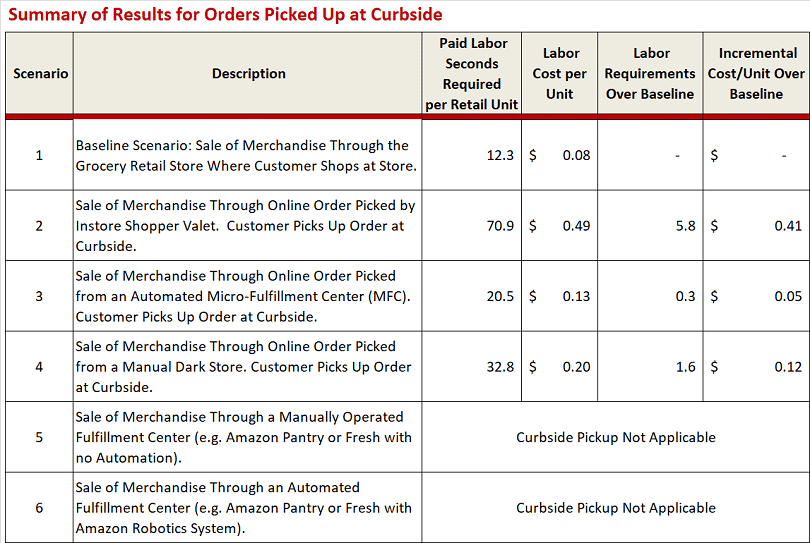
The above table depicts valid curbside pickup options. These results indicate $0.30 per unit is needed to pay for the home delivery option. In our experience, the cost to perform home delivery in the retail grocery context for suburban/metropolitan customers is in the range of $10 to $25 with the most typical deliveries costing $11 - $12 per delivery. When the customer is being charged less than this amount then the retailer is typically funding the difference. The numbers fluctuate because much depends on the number of deliveries being made per trip and the geography for the work being performed. More deliveries in a smaller area will be less costly than fewer deliveries in a larger area.
Let us say that the typical online order is for 22 items at a retail cost of $US 100. The above table indicates that if the customer shops their own order in the store then the paid labor cost for the order is $1.76. By the way, if the customer uses self-checkout then this actually drops to $1.21 which is the lowest cost of any scenario evaluated. Scenario 2 is the highest cost option whereby the in-store valet fulfills the online order. By comparison Scenario 2 generates $10.78 of labor cost to fill the same $100 order. It is important to note that currently this scenario represents how the vast majority of online orders are being fulfilled by supermarket retailers.
By applying MFC automation, we can see that the Scenario 3 order fulfillment labor cost drops to $2.86 to fill the same $100 order. This is an important finding for Grocery retailers as they seek ways to take the cost to fulfill online orders. It is also important to recognize that MFC automation does not handle 100% of the product volume being ordered online. The companies that have invested in MFC automation are working towards 50% of online transactions being fulfilled from the automation system, 30% being filled from an adjacent manual area in the back room of the store and the balance of 20% of the line items being fulfilled from in-store picking. So there is room to improve how MFCs are deployed and the industry is in the early stages of making improvements in this area.
Lastly, from an ethical perspective, especially during the coronavirus pandemic, the online shopper may wish to consider the impact of placing an online grocery order. This analysis indicates that the consumer who orders groceries from the comfort and safety of their home will require 5 to 9 times more paid labor resources then if they shopped in the store. That translates into more people going to work and being exposed to the risk of being infected. On the plus side it means more people who are actively employed so there are different ways to consider this issue depending on which lens you choose to look through.
We hope that the reader has gained some knowledge from this white paper and as always we are open for feedback.
Marc Wulfraat is the President of MWPVL International Inc. He can be reached at +(1) (514) 482-3572 Extension 100 or by clicking here. MWPVL International provides unbiased consulting services to help companies optimize their e-commerce fulfillment strategies to maximize efficiency for each market being serviced.

|